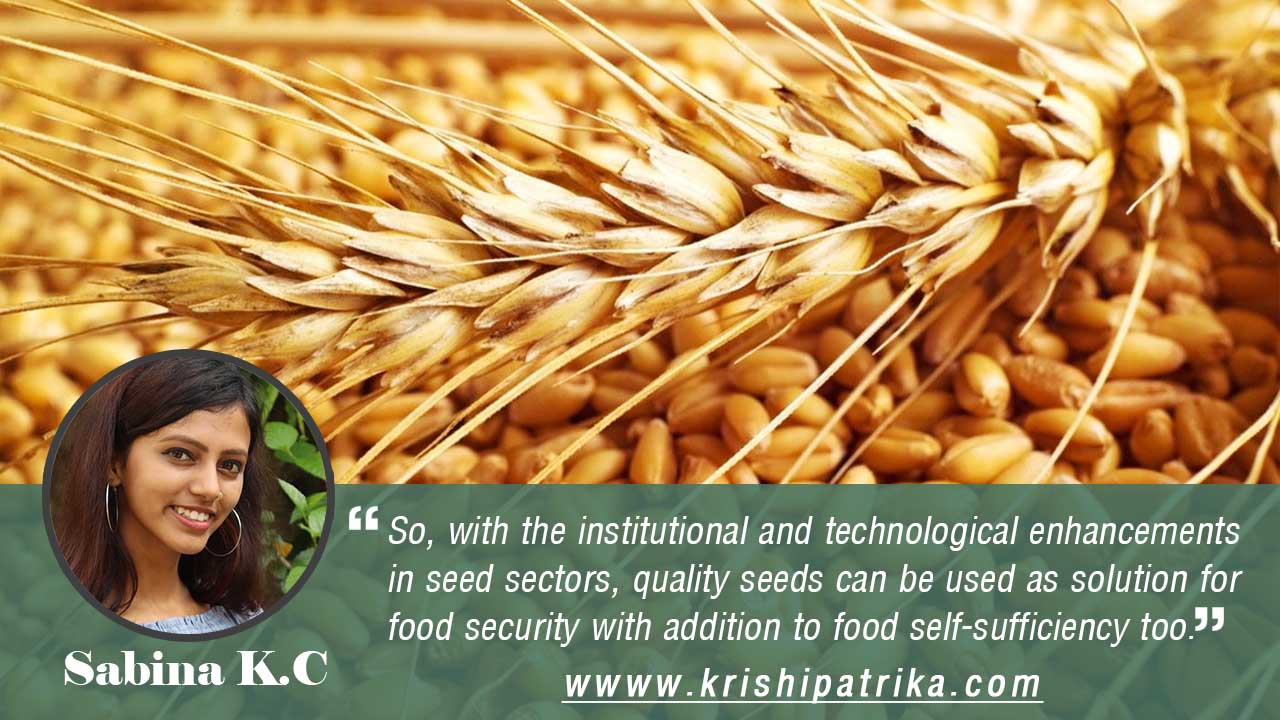
Seed system is one of the most vital components of agricultural system that serves as an important element in strategies for agricultural development and poverty reduction. COVID-19 pandemic has affected almost every system worldwide and Seed system is not devoid of its effects too. Seed supply chain has been disrupted badly with very minimal workers around this sector. Not only this sector but that of food safety, World Food security, has been affected severely as well. Importance of quality seeds is being understood, and is also being seen as basic tool for a secure food supply because of this havoc going around in the world. Seed quality is an essential trait for crop production and food security, particularly during the increasing uncertainty due to climate change. From resource-poor to industrial-scale farming, high seed quality is essential for crop production to be both sustainable and profitable, and is therefore widely accepted as a critically important agronomic trait. So, with the institutional and technological enhancements in seed sectors, quality seeds can be used as solution for food security with addition to food self-sufficiency too.
“Food security exists when all people, at all times, have physical and economic access to sufficient, safe and nutritious food that meets their dietary needs and food preferences for an active and healthy life”( 1996 World Food Summit). There are three main types of agri-food policy solutions aimed at food security:1.Food self-reliance 2.Food self-sufficiency 3.Food Sovereignty
Food Insecurity during COVID-19 in Nepal – India is one of the biggest contributor of food goods in Nepal. The shortage in the supply of vegetables from India, rice exports were also halted from India, affecting food availability dimension of food security. During the on-going of lockdown, the harvesting of Wheat all over Nepal was only completed by 30-40% at around 13th April and at the report of beginning of May it was completed by 80-90%, but the main problem here came by the restriction on supply of those harvested wheat due to no transportation. 85 percent of traders reported that the supply of goods decreased, with 90 percent of traders reporting a decrease in transporting trucks and other vehicles. While maize sowing is going on in Nepal, reports of Fall Army Worm infestation in newly germinated maize crop in some of the districts, has created fear on farmers. Localized hailstorms and strong wind have affected winter crops, vegetables and fruits in some parts of Provinces-1, 2, Bagmati, Gandaki, Karnali and Sudurpaschim (Source: WFP, 2020b).
The popularly viewed solution for solving food insecurity during this pandemic of COVID-19 is:
Availability of Quality Seeds – Quality Seed is the repository of the genetic potential of crop species and their varieties resulting from the continuous improvement and selection over time. The potential benefits of quality seed to crop productivity and food security can be enormous. Every farmer should able to access healthy seeds which are genetically pure, with high seed vigour and good germination percentage. Timely availability of good quality seeds at reasonable price ensures good yield and profit to the farmers. Quality seed can be defined as varietally pure with a high germination percentage, free from diseases and disease organisms, with a proper moisture content and weight. Quality seed production which follows efficient certification procedures plays a major role in the increase of food production of our country. The quality of seeds and young plants is important to end up with a good crop. Good seeds also contribute to the efficient use of resources by local farmers, promote job opportunities, lead to safer and healthier food, and dealing with effects of climate change. It ensures good germination, rapid emergence, and vigorous growth.
Quality Seeds as a Solution to Food Security and Food Self-sufficiency – With the observation of aforementioned qualities of quality seeds, we can come to certain understanding how much is quality of seeds important for better crop stand and high input efficiency. Producing quality seeds is an effective tool to address the issues of self-sufficiency, food security and economic development. For the assessment of quality seeds, main things that matter are purity, germination and moisture content of seed lot. For that, certified seeds are highly used, which have really purity. Certified seeds are of mainly four types: Nucleus seed, Breeder’s seed, Foundation Seed (I and II) and Certified Seed (I and II). If such seeds are
available to the farmers, then it can be advantageous for them in many perspectives like uniform plant population and maturity. As they are also found to be profitable in terms of monetary as farmers can get high return per unit area as the genetic potentiality of the crop be fully exploited, with the increased nutrient-use efficiency. It can be a sound material for transforming the agriculture of Nepal as it supports on the saving of money of poor farmers, and high production and supply in market from rural sides supporting GDP of country. Quality seeds also have organoleptic characteristics, which means compatible traits as per preference of locals i.e. for processing, cooking, colour and even taste characteristics also. So, quality seeds not only ensure on its ability to tackle some adverse natural conditions only, but also focuses on the preferences of consumers for their diet with high nutritional value. This supports on the fact that seeds coming via formal system is trustable as it comes down to market after complete inspection from field to lab, so it can prevent on the reduction of food insecurity that is resulted due to production of some un-preferred varieties. Production of seeds by following proper seed cycle, unifying seed system with complete knowledge and technological training on post-harvest operations up to marketing, utilization of maximum seed policies, seed schemes national, international both needs to be done in order to be self reliable, sustainable, standard in line with sustaining food security and enhancing productivity.









